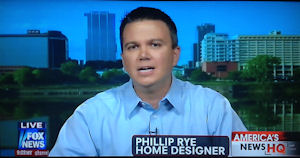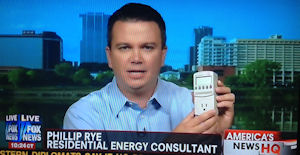
|
|
|
|
 |
||
|
|
|
Hello Friend,
My name is Phillip Rye. My dad, Doug Rye, and I have over 40 years of combined experience in home teaching people just like you how to have lower utility bills. Doug began his career as a licensed architect for the Federal Government at the Farmers Home Administration (FHA). He has spent the past 30 years teaching people all across America how to have lower utility bills and a more comfortable home for their family.
I began my career as a licensed civil engineer and have spent the past 15+ years working alongside Doug researching and studying home electrical usuage and how energy conservation affects our environment.
As you read this report or our websites (www.dougrye.com and www.philliprye.com), you will probably notice that we both heavily lean towards using a residential geothermal heat pump system. This is truly an unbiased view of the most energy efficient heating and cooling system available. Neither of us receives compensation of any kind for recommending a geothermal heat pump system.
Can you heat and cool your home without using a geothermal heat pump? Yes.
Does a geothermal heat pump outperform any other system when it comes to energy efficiency? Yes it
does.
The decision is up to YOU. Our goal and mission is to educate you, the consumer, so you can make a wise choice when it comes to lowering utility bills in your home.
Whether you are building an new home or want lower utility bills in your existing home, Doug's VHS/DVD's are a must have if you want to do things right and save money.
|
Sample Key Points and Their Benefits from the VHS/DVD:
|
Understanding Air Conditioners
Many people buy or use air conditioners without understanding their designs, components, and operating principles. Proper sizing, selection, installation, maintenance, and correct use are keys to cost-effective operation and lower overall costs.
Many people think that bigger is better when it comes to a home heating and cooling system, but an oversized unit leads to higher utility bills, higher installation costs, shorter equipment life, and less comfort for you and your family.
Ninety percent of homes in America have the least energy efficient heating and air system allowed by law. When selecting an air conditioner, it is very important to select the most efficient system possible.
How Air Conditioners Work
Air conditioners (also called air-to-air heat pumps) employ the same operating principles and basic components as your home refrigerator. An air conditioner cools your home with a cold indoor coil called the evaporator.
The condenser, a hot outdoor coil, releases the collected heat outside. The evaporator and condenser coils are serpentine tubing surrounded by aluminum fins. This tubing is usually made of copper. A pump, called the compressor, moves a heat transfer fluid (or refrigerant) between the evaporator and the condenser. The pump forces the refrigerant through the circuit of tubing and fins in the coils.
The liquid refrigerant evaporates in the indoor evaporator coil, pulling heat out of indoor air and thereby cooling the home. The hot refrigerant gas is pumped outdoors into the condenser where it reverts back to a liquid giving up its heat to the air flowing over the condenser's metal tubing and fins.
A geothermal heat pump works in the same manner but is much more efficient. The geothermal heat pump has NO outdoor equipment and uses solar energy, a renewable energy source, stored in the earth as a heat transfer.
Instead of releasing the collected heat outside like an air-to-air heat pump, a geothermal heat pump can put that excess heat in your water heater resulting FREE hot water and lower utility bills. Doug Rye's energy saving video has illustrations and explains geothermal in great detail.
Types of Air Conditioners
Central air conditioners circulate cool air through a system of supply and return ducts. Supply ducts and registers (i.e., openings in the walls, floors, or ceilings covered by grills) carry cooled air from the air conditioner to the home. This cooled air becomes warmer as it circulates through the home; then it flows back to the central air conditioner through return ducts and registers. A central air conditioner is either a split-system unit or a packaged unit.
In a split-system central air conditioner, an outdoor metal cabinet contains the condenser and compressor, and an indoor cabinet contains the evaporator. In many split-system air conditioners, this indoor cabinet also contains a furnace or the indoor part of a heat pump. The air conditioner's evaporator coil is installed in the cabinet or main supply duct of this furnace or heat pump. If your home already has a furnace but no air conditioner, a split-system is the most economical central air conditioner to install.
In a packaged central air conditioner, the evaporator, condenser, and compressor are all located in one cabinet, which usually is placed on a roof or on a concrete slab next to the house's foundation. This type of air conditioner also is used in small commercial buildings.
Air supply and return ducts come from indoors through the home's exterior wall or roof to connect with the packaged air conditioner, which is usually located outdoors. Packaged air conditioners often include electric heating coils or a natural gas furnace. This combination of air conditioner and central heater eliminates the need for a separate furnace indoors.
Geothermal heat pumps are a packaged system. The geothermal heat pump is all electric and is capable of providing heating and cooling a super high efficiencies.
Maintaining Existing Air Conditioners
Older air conditioners may still be able to offer years of relatively efficient use. However, making your older air conditioner last requires you to perform proper operation and maintenance.
Air Conditioning Problems
One of the most common air conditioning problems is improper operation. If your air conditioner is on, be sure to
close your home's windows and outside doors.
Other common problems with existing air conditioners result from faulty installation, poor service procedures, and inadequate maintenance. Improper installation of your air conditioner can result in leaky ducts and low airflow. Many times, the refrigerant charge (the amount of refrigerant in the system) does not match the manufacturer's specifications. If proper refrigerant charging is not performed during installation, the performance and efficiency of the unit is impaired. Service technicians often fail to find refrigerant charging problems or even worsen existing problems by adding refrigerant to a system that is already full. Air conditioner manufacturers generally make rugged, high quality products. If your air conditioner fails, it is usually for one of the common reasons listed below:
-
refrigerant leaks. If your air conditioner is low on refrigerant, either it was undercharged at installation, or it leaks. If it leaks, simply adding refrigerant is not a solution. A trained technician should fix any leak, test the repair, and then charge the system with the correct amount of refrigerant. Remember that the performance and efficiency of your air conditioner is greatest when the refrigerant charge exactly matches the manufacturer's specification, and is neither undercharged nor overcharged.
-
inadequate maintenance. If you allow filters and air conditioning coils to become dirty, the air conditioner will not work properly, and the compressor or fans are likely to fail prematurely.
-
electric control failure. The compressor and fan controls can wear out, especially when the air conditioner turns on and off frequently, as is common when a system is oversized. Because corrosion of wire and terminals is also a problem in many systems, electrical connections and contacts should be checked during a professional service call.
Regular Maintenance
An air conditioner's filters, coils, and fins require regular maintenance for the unit to function effectively and efficiently throughout its years of service. Neglecting necessary maintenance ensures a steady decline in air conditioning performance while energy use steadily increases.
Air Conditioner Filters
The most important maintenance task that will ensure the efficiency of your air conditioner is to routinely replace
or clean its filters. Clogged, dirty filters block normal airflow and reduce a system's efficiency significantly.
With normal airflow obstructed, air that bypasses the filter may carry dirt directly into the evaporator coil and
impair the coil's heat-absorbing capacity. Filters are located somewhere along the return duct's length. Common
filter locations are in walls, ceilings, furnaces, or in the air conditioner itself.
Some types of filters are reusable; others must be replaced. They are available in a variety of types and efficiencies. Clean or replace your air conditioning system's filter or filters every month or two during the cooling season. Filters may need more frequent attention if the air conditioner is in constant use, is subjected to dusty conditions, or you have fur-bearing pets in the house.
Air Conditioner Coils
The air conditioner's evaporator coil and condenser coil collect dirt over their months and years of service. A
clean filter prevents the evaporator coil from soiling quickly. In time, however, the evaporator coil will still
collect dirt. This dirt reduces airflow and insulates the coil, which reduces its ability to absorb heat.
Therefore, your evaporator coil should be checked every year and cleaned as necessary.
Outdoor condenser coils can also become very dirty if the outdoor environment is dusty or if there is foliage nearby. You can easily see the condenser coil and notice if dirt is collecting on its fins.
You should minimize dirt and debris near the condenser unit. Your dryer vents, falling leaves, and lawn mower are all potential sources of dirt and debris. Cleaning the area around the coil, removing any debris, and trimming foliage back at least 2 feet (0.6 meters) allow for adequate airflow around the condenser.
Coil Fins
The aluminum fins on evaporator and condenser coils are easily bent and can block airflow through the coil. Air
conditioning wholesalers sell a tool called a "fin comb" that will comb these fins back into nearly original
condition.
Sealing and Insulating Air Ducts
An enormous waste of energy occurs when cooled air escapes from supply ducts or when hot attic air leaks into return ducts. Recent studies indicate that 10% to 30% of the conditioned air in an average central air conditioning system escapes from the ducts.
For central air conditioning to be efficient, ducts must be airtight. Hiring a competent professional service technician to detect and correct duct leaks is a good investment, since leaky ducts may be difficult to find without experience and test equipment. Ducts must be sealed with duct "mastic." The old standby of duct tape is ineffective for sealing ducts.
Duct tape is also known as "temporary" tape. Duct tape was never designed to withstand extreme temperatures of an attic. Duct mastic works much like a cast for a broken bone. A mesh material is dipped in a plaster and then wrapped around the joints. This joint is so strong that the ductwork would have to collapse before the joint gave way.
Another option for sealing ductwork joints is aluminum tape. This tape is strong, easy to apply and works very well.
Both duct mastic and aluminum tape can be found any major home center such as Home Depot or Lowe's.
Obstructions can impair the efficiency of a duct system almost as much as leaks. You should be careful not to obstruct the flow of air from supply or return registers with furniture, drapes, or tightly fitted interior doors. Dirty filters and clogged evaporator coils can also be major obstructions to airflow.
The large temperature difference between attics and ducts makes heat conduction through ducts almost as big a problem as air leakage and obstructions. Ducts in attics should be insulated heavily in addition to being made airtight.
Doug Rye's energy saving video for existing homes covers topics such as duct leakage, fixing air leaks, blower door tests, and shows an actual section of ductwork sealed with duct mastic.
Click here now to order this energy saving video and learn other ways you can start saving money by making your home energy efficient.
Buying New Air Conditioners
Today's best air conditioners use 30% to 50% less energy to produce the same amount of cooling as air conditioners made in the mid 1970s. Even if your air conditioner is only 10 years old, you may save 20% to 40% of your cooling energy costs by replacing it with a newer, more efficient model.
Sizing Air Conditioners
Air conditioners are rated by the number of British Thermal Units (Btu) of heat they can remove per hour. Another
common rating term for air conditioning size is the "ton," which is 12,000 Btu per hour.
How big should your air conditioner be? The size of an air conditioner depends on:
-
how large your home is and how many windows it has;
-
how much shade is on your home's windows, walls, and roof;
-
how much insulation is in your home's ceiling and walls;
-
how much air leaks into your home from the outside; and
-
how much heat the occupants and appliances in your home generate.
An air conditioner's efficiency, performance, durability, and initial cost depend on matching its size to the above factors.
Make sure you buy the correct size of air conditioner. Two groups—the Air Conditioning Contractors of America (ACCA) and the American Society of Heating, Refrigerating, and Air Conditioning Engineers (ASHRAE)—publish calculation procedures for sizing central air conditioners. Reputable air conditioning contractors will use one of these procedures, often performed with the aid of a computer, to size your new central air conditioner.
DO NOT, DO NOT, and I repeat DO NOT let anyone install your air conditioning system without first using an approved computer program to size it correctly for your home. Too many homeowners allow the contractor to estimate or guess the size of the system. This nearly always results in an uncomfortable home.
Ask for a copy of the calculations before installation. A reputable contractor will be happy to provide them for you.
Be aware that a large air conditioner will not provide the best cooling. Buying an oversized air conditioner penalizes you in the following ways:
-
It costs more to buy a larger air conditioner than you need.
-
The larger-than-necessary air conditioner cycles on and off more frequently, reducing its efficiency. Frequent cycling makes indoor temperatures fluctuate more and results in a less comfortable environment. Frequent cycling also inhibits moisture removal. In humid climates, removing moisture is essential for acceptable comfort. In addition, this cycling wears out the compressor and electrical parts more rapidly.
-
A larger air conditioner uses more electricity and creates added demands on electrical generation and delivery systems.
Building a new home? Visit www.dougrye.com to find out how Doug Rye uses his 30 years of experience to size your heating and cooling system and give you a written guarantee on your average heating and cooling bills. Everyone building a new home needs to take advantage of this great offer to save money and insure a comfortable home for you and your family.
Along with this written guarantee, you will be provided with a comprehensive list of things to implement when building your new home, including a room-by-room heating and cooling analysis.
Air Conditioner Efficiency
Each air conditioner has an energy-efficiency rating that lists how many Btu per hour are removed for each watt of power it draws. For central air conditioners, it is the Seasonal Energy Efficiency Ratio, or SEER. These ratings are posted on an Energy Guide Label, which must be conspicuously attached to all new air conditioners.
In general, new air conditioners with higher SEERs sport higher price tags. However, the higher initial cost of an energy-efficient model will be repaid to you several times during its life span. Your utility company may encourage the purchase of a more efficient air conditioner by rebating some or all of the price difference. Buy the most efficient air conditioner you can afford, especially if you use (or think you will use) an air conditioner frequently and/or if your electricity rates are high.
Central Air Conditioners—SEER
National minimum standards for central air conditioners require a SEER of 9.7 and 10.0, for single-package and
split-systems, respectively. But you do not need to settle for the minimum standard—there is a wide selection of
units with SEERs reaching nearly 17.
As stated earlier in this report, ninety percent of homes in America have the least energy efficient heating and air system allowed by law. As quoted by the Trane heating and air manufacturing company, "As of 1992, federal regulations require all new split system central air conditioners have a SEER of at least 10".
Do not settle for the minimum that law will allow. Become an educated consumer and make a smart purchase.
Before 1979, the SEERs of central air conditioners ranged from 4.5 to 8.0. Replacing a 1970s-era central air conditioner with a SEER of 6 with a new unit having a SEER of 12 will cut your air conditioning costs in half.
It is worth noting that a geothermal heat pump does not have a SEER. The heat exchanging process of a geothermal system takes place under ground where it is a constant temperature all year. The geothermal system doesn't know if it's 100°F or -10°F outside.
Visit www.dougrye.com or www.philliprye.com for more information.
Hiring Professional Service
When your air conditioner needs more than the regular maintenance described previously, hire a professional service technician. A well-trained technician will find and fix problems in your air conditioning system. However, not all service technicians are competent. Incompetent service technicians forsake proper diagnosis and perform only minimal stopgap measures. Insist that the technician:
-
check for correct amount of refrigerant;
-
test for refrigerant leaks using a leak detector;
-
capture any refrigerant that must be evacuated from the system, instead of illegally releasing it to the atmosphere;
-
check for and seal duct leakage in central systems;
-
measure airflow through the evaporator coil;
-
verify the correct electric control sequence and make sure that the heating system and cooling system cannot operate simultaneously;
-
inspect electric terminals, clean and tighten connections, and apply a non-conductive coating if necessary;
-
oil motors and check belts for tightness and wear; and
-
check the accuracy of the thermostat.
Choosing a Contractor
Choosing a contractor may be the most important and difficult task in buying a new central air conditioning system. Ask prospective contractors for recent references. If you are replacing your central air conditioner, tell your contractor what you liked and did not like about the old system. If the system failed, ask the contractor to find out why. The best time to fix existing problems is when a new system is being installed.
When designing your new air conditioning system, the contractor you choose must:
-
use a computer program or written calculation procedure to size the air conditioner;
-
provide a written contract listing the main points of your installation that includes the results of the cooling load calculation;
-
give you a written warranty on equipment and workmanship; and
-
allow you to hold the final payment until you are satisfied with the new system.
Avoid making your decision solely on the basis of price. The quality of the installation should be your highest priority, because quality will determine utility cost, comfort, and durability.
Installation and Location of Air Conditioners
If your air conditioner is installed correctly, or if major installation problems are found and fixed, it will perform efficiently for years with only minor routine maintenance. However, many air conditioners are not installed correctly. As an unfortunate result, modern energy-efficient air conditioners can perform almost as poorly as older inefficient models.
Be sure that your contractor performs the following procedures when installing a new central air conditioning system:
-
allows adequate indoor space for the installation, maintenance, and repair of the new system, and installs an access door in the furnace or duct to provide a way to clean the evaporator coil.
-
uses a duct-sizing methodology such as the Air Conditioning Contractors of America (ACCA) Manual D.
-
ensures there are enough supply registers to deliver cool air and enough return air registers to carry warm house air back to the air conditioner.
-
installs ductwork within the conditioned space, not in the attic, wherever possible.
-
seals all ducts with duct mastic and heavily insulates attic ducts.
-
locates the condensing unit where its noise will not keep you or your neighbors awake at night, if possible.
-
places the condensing unit in a shady spot, if possible, which can reduce your air conditioning costs by 1% to 2%.
-
verifies that the newly installed air conditioner has the exact refrigerant charge and airflow rate specified by the manufacturer.
-
locates the thermostat away from heat sources, such as windows, or supply registers.
If you are replacing an older or failed split system, be sure that the evaporator coil is replaced with a new one that exactly matches the condenser coil in the new condensing unit. (The air conditioner's efficiency will likely not improve if the existing evaporator coil is left in place; in fact, the old coil could cause the new compressor to fail prematurely.)
Paying attention to your air conditioning system saves you money and reduces environmental pollution. Notice whether your existing system is running properly, and maintain it regularly. Or, if you need to purchase a new air conditioner, be sure it is sized and installed correctly and has a good SEER rating.
Using Your Air Conditioner
Many of you have heard of programmable thermostats or night setback savings. A programmable thermostat allows you to set the time of day that your air conditioner will come on or turn off. For example, it may turn off 30 minutes after you leave for work and come on 30 minutes before you get home.
Night setback savings refers to setting you thermostat so that your air conditioner will not run at night. Theoretically this will save you money. However, more times than not, your air conditioner will actually run longer trying to "catch-up" from the time that is was off.
If you have an energy efficient home, there is no need for a programmable thermostat or night setback. Set your thermostat to a comfortable temperature and leave it. Just think, now you can go on that week vacation and not worry about if your utility bill will drain your bank account.
You can now come home to a comfortable house and sleep at night in a nicely conditioned room.
---------------------------------------------------------------
If you want to take control of our utility bills and save money, visit www.dougrye.com.
Are you building a home and looking for a custom, energy efficient home plan? Visit my home design site at www.rye-homes.com for more information.
by - Phillip Rye
Back to
Top

Phillip Rye - As Seen On Fox News


| Home Builder |
| Geothermal |
| Insulation |
| New Home Design |
| Ultimate Energy Action Guide |
XSitePro Templates






